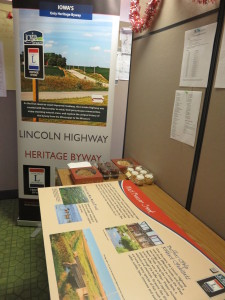-
Interpretive Panel to be placed at Lion’s Tree Club Park along the Lincoln Highway
- Posted on December 15, 2015
- by ILeditorHA
- in Uncategorized
- Comments Off on Interpretive Panel to be placed at Lion’s Tree Club Park along the Lincoln Highway

Panel and Banner ©Jessica Johnson
AMES, IOWA – The Lincoln Highway Heritage Byway is proud to announce that two conservation
interpretive signs will be installed in central Iowa sites as part of a Conservation Innovation Grant (CIG)
and Resource Enhancement and Protection (REAP) grant. One of the selected locations to receive this
interpretive panel is located near Grand Junction. Bob and Joyce Ausberger, representatives of the Iowa
Lincoln Highway Association and the Lion’s Tree Club Park Committee, accepted their sign recently. The
interpretive panel talks about buffers, streams, and watersheds. It will be installed near Beaver Creek at
the Lion’s Tree Club Park on the east side of Grand Junction where the Lincoln Highway and Highway 30
separate.The eleven Byways in Iowa worked in concert with each other on this project. Each Byway was to
produce two interpretive panels that described conservation practices nearby. Locations were selected
based on visible conservation practices in the nearby area and ease of the traveler to safely pull off the
road to read the signs. A similar sign will be placed at the Lincoln Prairie Park on the west side of Ogden
describing prairie plants and their benefits.“The Lion’s Tree Club Park is a unique interpretive location for Lincoln Highway road. We are so happy to
work with the Iowa Lincoln Highway Association and the Lion’s Tree Club Park Committee and present
them with this interpretative panel,” said Jan Gammon, Prairie Rivers of Iowa’s Lincoln Highway
Coordinator.The Iowa Byways Program is an Iowa Department of Transportation program. Prairie Rivers of Iowa is
contracted to manage the Lincoln Highway Heritage Byway. The Lincoln Highway was the first
transcontinental road in the United States, starting in Times Square and ending in San Francisco. In Iowa,
it travels from Clinton to Council Bluffs, including the cities of Boone, Ogden, and Beaver in Boone
County.
If you enjoyed this article please consider sharing it!
TypeError thrown
base64_decode(): Argument #1 ($string) must be of type string, array given




